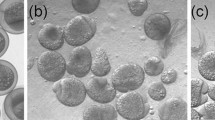Summary
When horseshoe crab embryos were treated with NaHCO3 at the developmental stage when the germ disc appears, multiple embryos were formed. NaHCO3 may effect the formation of multiple embryos by binding Ca2+ ions of the embryo since multiple embryos were also formed by treatment with Ca2+ free sea water.
The treatment caused the blastoderm layer to tear. When the embryos were returned to normal sea water after the treatment, the blastoderm recovered. Some cell masses, probably derived from the germ disc or its prospective cells, formed during the process of the recovery. Each cell mass developed into an embryo.
Similar content being viewed by others
References
Cantino, E.C.: Relations of metabolism to cell development in plants. Handb. Pflanzenphysiologie14, 213–233 (1964)
Ehn A.: The development of spider embryos after centrifugation. Zool. Bidrag, Uppsala35, 339–368 (1962)
Ehn, A.: Effects of sulphydryl-blocking substances on development of spider embryos. Zool. Bidrag, Uppsala36, 49–76 (1963)
Ehn, A. Aspects of determination in the spider embryo. Zool. Bidrag, Uppsala37, 3–20, (1964)
Giudice, G.: Restitution of whole larvae from disaggregated cells of sea urchin embryos. Dev. Biol5, 402–411 (1962)
Herbst, C.: Über das Auseinandergehen von Furchungs-und Gewebezellen in Kalkfreiem Medium. Arch. Entwicklungsmech. Org.9, 424–463 (1900)
Holm, Å: Experimentelle Untersuchungen über die Entwicklung und Entwicklungsphysiologie des Spinnenembryos. Zool. Bidrag, Uppsala29, 293–430 (1952)
Juberthie, C.: Teratologie experimentale chez un Opilion (Arachnide). J. Embryol. Exp. Morphol.19, 49–82 (1968)
Kautzsch, G.: Über die Entwicklung vonAgelena labyrinthica Clerck. Zool. Jahrb. Abt. Anat. Ontog. Tiere28, 477–538 (1909)
Krause, G.: Induktionssysteme in der Embryonalentwicklung von Insekten. Ergeb. Biol.20, 159–198 (1958)
Loomis, W.F., Lenhoff, H.M.: Growth and sexual differentiation of Hydra in mass culture. J. Exp. Zool.132, 555–574 (1956)
Mikulska, I., Jacuñski, L.: A two-headed Monster of the spiderTegenaria atrica. (C.L. Koch, ed.) Acta Arachnol23, 17–19 (1970)
Oka, H.: Recherches sur l'embryologie causale de Limule. Sci. Rep. Tokyo Bunrika Daigaku, Sect. B:6–95, 87–128 (1943)
Sekiguchi, K.: Reduplication in spider eggs produced by centrifugation. Sci. Rep. Tokyo Kyoiku Daigaku Sect. B:8–130, 187–240 (1957)
Sekiguchi, K.: Determination in the development of the Horse-shoe crab (in Japanese). J. Exp. Morphol.20, 84–89 (1966)
Sekiguchi, K.: A normal plate of the development of the Japanese horse-shoe crab,Tachypleus tridentatus. Sci. Rep. Tokyo Kyoiku Daigaku Sect. B:15–229, 153–162 (1973)
Author information
Authors and Affiliations
Additional information
Contributions from the Shimoda Marine Research Center, Nor. 348
Rights and permissions
About this article
Cite this article
Itow, T., Sekiguchi, K. Induction of multiple embryos with NaHCO3 or calcium free sea water in the horseshoe crab. Wilhelm Roux' Archiv 187, 245–254 (1979). https://doi.org/10.1007/BF00848620
Received:
Accepted:
Issue Date:
DOI: https://doi.org/10.1007/BF00848620




